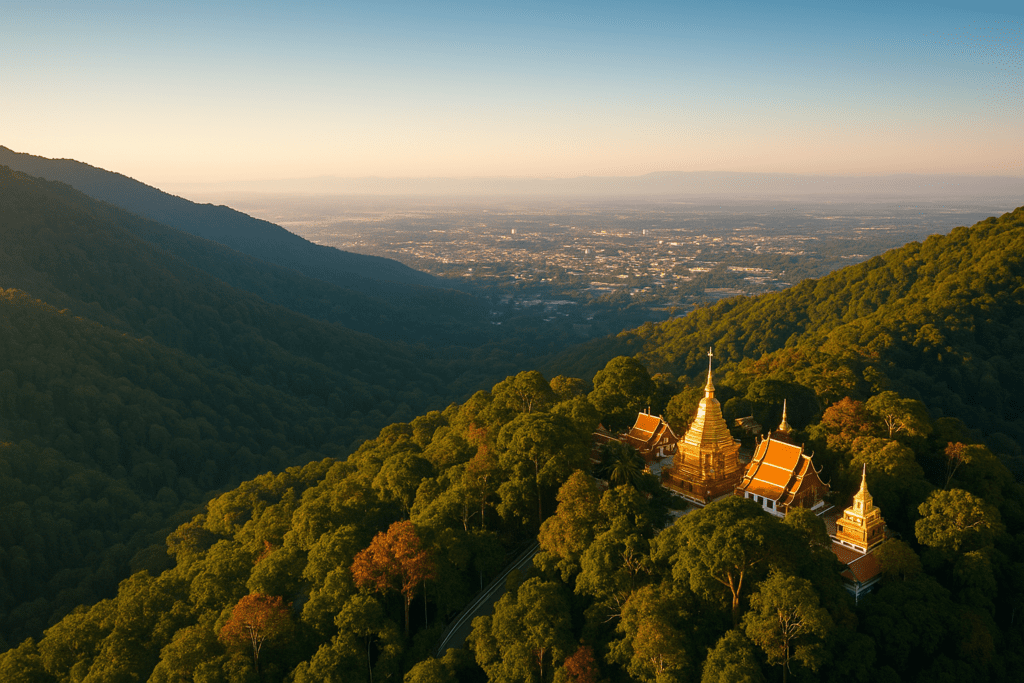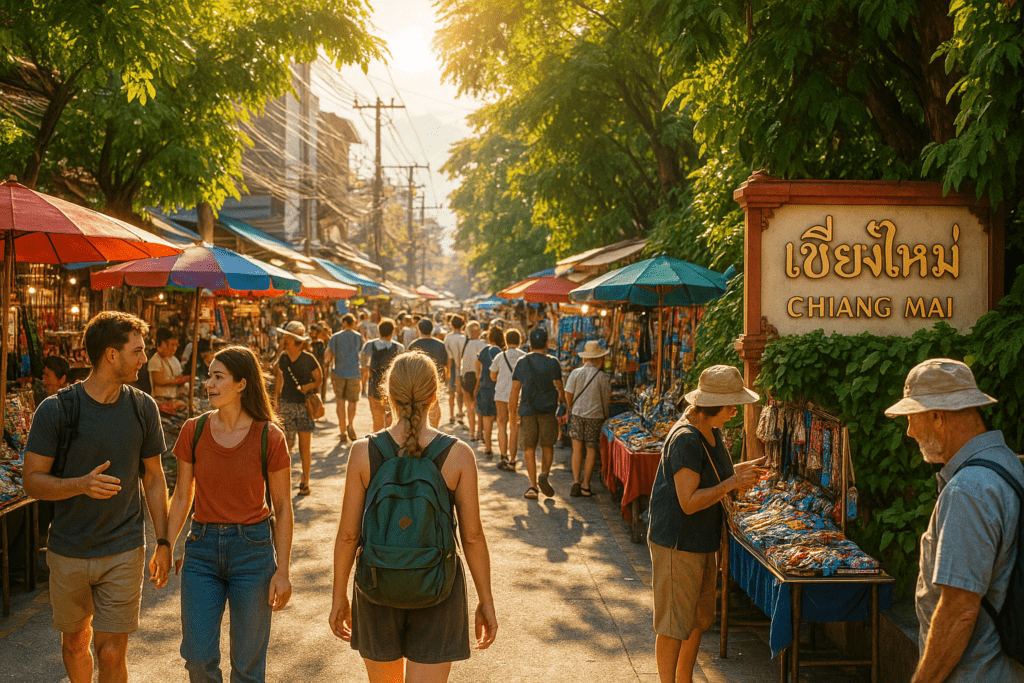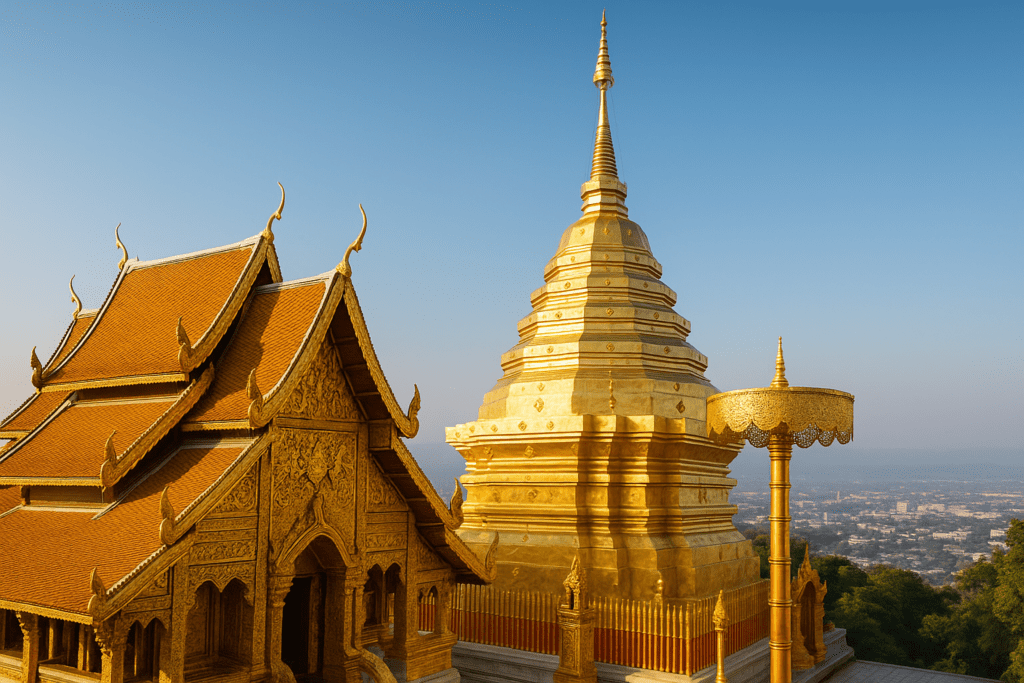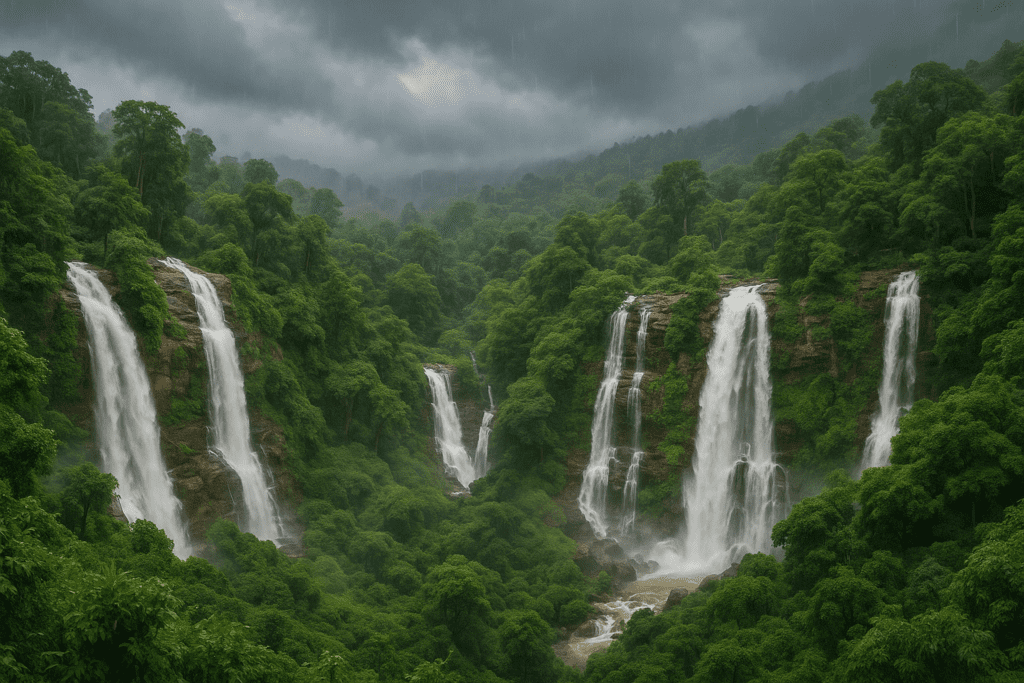Key Takeaways
- The best time to visit Chiang Mai is during the cool season (November-February) with perfect weather and minimal rainfall
- Avoid March-April due to extreme heat and burning season haze, and August-September for heavy monsoon rains
- Cool season offers ideal conditions for outdoor activities, trekking, and temple visits with temperatures of 25-30°C
- November is perfect for Yi Peng Lantern Festival, while shoulder months offer budget-friendly options with fewer crowds
- Rainy season (May-October) brings lush landscapes and lower prices but requires flexible planning
Table of Contents
- An Overview of Chiang Mai’s Climate: The Three Main Seasons
- A Comprehensive Look: Chiang Mai Weather by Month
- The Verdict: The Absolute Best Time to Visit Chiang Mai Weather-Wise
- Exploring During the Chiang Mai Cool Season Months
- The Chiang Mai Rainy Season: Is It a Time to Avoid?
- Identifying the Worst Time to Visit Chiang Mai
- Conclusion: Deciding When to Go

Figuring out when to visit Chiang Mai is the first step to an unforgettable trip. This city in Northern Thailand transforms dramatically with the seasons, and your experience can be defined by the weather, the crowds, and the vibrant festivals you encounter.
This post is your ultimate resource for choosing the perfect travel dates. We’ll break down the best time to visit Chiang Mai weather-wise, explore the Chiang Mai weather by month, and tell you which periods, like the notorious Chiang Mai rainy season, you might want to avoid. For a quicker overview of seasonal highlights and festival timing, check out our What is the Best Time to Visit Chiang Mai for Your Perfect Trip?.
You’ll get a detailed look at the three distinct seasons, a month-by-month climate guide, and insights into planning around major events like Songkran and the Yi Peng Lantern Festival.

An Overview of Chiang Mai’s Climate: The Three Main Seasons
Before diving into the nitty-gritty details, let’s get the big picture sorted. Chiang Mai follows a tropical savanna climate pattern that’s refreshingly predictable once you understand it. When to visit Chiang Mai really comes down to understanding these three distinct seasons.
The Cool Season (November – February) is what everyone raves about. Think pleasant, dry weather with those Instagram-perfect clear blue skies, lower humidity, and evenings cool enough that you’ll actually want a light jacket. January hits the sweet spot as the coolest month, with highs around 29-30°C during the day and surprisingly refreshing lows near 14-17°C at night. It’s no wonder this is peak tourist season.
The Hot Season (March – May) cranks up the intensity significantly. Temperatures climb relentlessly during this period, peaking in April when you’ll see the thermometer hit 36–38°C, and even the nights stay uncomfortably warm. But here’s the kicker – this season also brings the infamous “burning season.” Agricultural burning fills the air with smoke and haze, particularly brutal in March and April, when the air quality can become genuinely unpleasant.
The Rainy Season (mid-May/June – October) is monsoon territory. The humidity shoots up, and you can expect frequent, heavy downpours that typically roll in during the afternoon. The upside? The landscape becomes incredibly lush and green – it’s actually quite beautiful if you don’t mind getting soaked. July through September are usually the wettest months, when Mother Nature really shows off her power. You can learn more about Chiang Mai’s climate patterns to understand how these seasonal shifts affect daily life in the city.
Chiang Mai sits pretty at 300 meters above sea level, with mountains all around that help moderate the temperatures compared to somewhere like Bangkok. Don’t expect a true winter with frost though – this is still tropical Thailand, just with more comfortable variations.
A Comprehensive Look: Chiang Mai Weather by Month
Let’s break down the Chiang Mai weather by month with the specific numbers you need to plan properly. I’m giving you the real data here, not just vague descriptions.
January: Avg High 28-30°C | Avg Low 14-17°C | Rainfall 7-10mm
Peak tourist season with cool, dry, and sunny days. Perfect for literally everything you want to do outdoors.
February: Avg High 30-32°C | Avg Low 15-20°C | Rainfall 5-30mm
Still lovely and dry, but you’ll notice temperatures beginning to climb. Air quality can start declining late in the month as burning season approaches.
March: Avg High 34-35°C | Avg Low 18-25°C | Rainfall 13-50mm
It’s getting seriously hot and hazy due to the burning season. Mostly dry, but the smoke can be a real problem.
April: Avg High 36-38°C | Avg Low 22-28°C | Rainfall 50-70mm
The absolute hottest month of the year. Thank goodness for Songkran’s water festival – those water fights aren’t just fun, they’re survival tactics.
May: Avg High 34°C | Avg Low 24-25°C | Rainfall 150-158mm
The heat continues its assault, but salvation arrives with the first monsoon rains. Humidity increases, but at least the air starts clearing.
June: Avg High 32°C | Avg Low 24°C | Rainfall 132-200mm
The rainy season is officially underway. Expect sunny mornings followed by dramatic afternoon downpours. The countryside starts turning that incredible shade of green.
July: Avg High 31-32°C | Avg Low 24°C | Rainfall 161-230mm
Regular downpours become your new reality, but honestly, the lush countryside is beautifully dramatic. Plus, way fewer crowds.
August: Avg High 31-32°C | Avg Low 24°C | Rainfall 236-250mm
One of the wettest months. High chance your outdoor plans will need some serious flexibility due to heavy rain.
September: Avg High 31°C | Avg Low 23-24°C | Rainfall 228-300mm
The peak of monsoon madness. Highest rainfall and the biggest risk of flooding. Not ideal for most travelers.
October: Avg High 30-31°C | Avg Low 22°C | Rainfall 122-200mm
The light at the end of the tunnel. Rains begin to ease up, temperatures cool down, and humidity drops. This is actually a fantastic shoulder month.
November: Avg High 28-30°C | Avg Low 15-19°C | Rainfall 20-53mm
The start of the perfect season. Dry, cool, and home to those magical Yi Peng and Loi Krathong festivals everyone talks about.
December: Avg High 25-28°C | Avg Low 14-15°C | Rainfall 10-20mm
Absolutely fantastic weather for outdoor adventures. Cool evenings and bright, sunny days that make you remember why you love traveling.
This detailed weather data comes from multiple meteorological sources and reflects long-term averages, though individual years can vary.
The Verdict: The Absolute Best Time to Visit Chiang Mai Weather-Wise
The consensus is crystal clear: the best time to visit Chiang Mai weather is during the cool and dry season, which runs from late October to February.
Here’s why this window is absolutely perfect. The temperatures hit that Goldilocks zone with daily highs between 25-30°C – warm enough for shorts and t-shirts, but not so hot that you’re melting into a puddle by noon. The evenings are genuinely refreshing, dropping to 14-20°C, which means you can actually enjoy outdoor dining and night markets without feeling like you’re in a sauna.
The minimal rainfall during these months creates those postcard-perfect clear skies that make every photo look professional. We’re talking about less than 50mm of rain per month, often much less. That consistent sunshine gives you that ideal light photographers dream about, plus you can actually plan outdoor activities without constantly checking the weather app.
Now, let’s talk specifics within this golden window. November and December are particularly special because they coincide with magical Yi Peng Lantern Festival and Loi Krathong festivals everyone talks about. And to make the most of festival hopping, renting a motorbike from Byklo is a game-changer. January represents the peak of comfort with the least amount of rain, making it absolutely perfect for hikers and anyone wanting to explore the surrounding mountains and national parks.
Here’s a pro tip: hotel rates are often significantly lower at the beginning of this window, particularly in October and early November, before the festival crowds arrive and jack up prices. You can enjoy nearly identical weather conditions while saving a substantial amount on accommodation. Highlights Travel confirms that this period offers the best balance of weather, activities, and value for most travelers.

Exploring During the Chiang Mai Cool Season Months
The Chiang Mai cool season months – November, December, January, and February – represent the absolute sweet spot for outdoor exploration and adventure.
This is when all those activities you’ve been dreaming about become not just possible, but genuinely enjoyable. Trekking in Doi Inthanon National Park is spectacular during these months, with clear trails and breathtaking mountain views. The famous Doi Suthep temple offers those panoramic city views everyone posts on Instagram, but during cool season, you can actually enjoy the climb without feeling like you’re going to collapse from heat exhaustion. For more on temple exploration, see our Exploring Chiang Mai’s Temples by Motorbike.
The mild weather and stunning scenery make this the ideal time to explore beyond the city limits. Renting a scooter gives you the freedom to discover hidden temples and waterfalls at your own pace. A reliable service like Byklo can get you set up with a well-maintained bike for your adventure.
Let’s talk packing strategy for these months, because getting this wrong can really affect your comfort. Bring light clothing for the day – think t-shirts, shorts, and sundresses – but don’t make the rookie mistake of skipping warm layers. Pack a light jacket, sweater, or fleece for the surprisingly cool mornings and evenings, especially if you’re venturing into the mountains where temperatures can drop even further. I can’t stress this enough: those mountain mornings can feel genuinely cold when you’re expecting tropical weather.
Don’t forget sunglasses and sunscreen for the strong daytime sun. The clear skies that make this season so beautiful also mean UV rays are intense, and the mountain elevation can intensify sun exposure.

The Chiang Mai Rainy Season: Is It a Time to Avoid?
If your top priority is dry weather for outdoor activities, then you should definitely plan to avoid the core Chiang Mai rainy season from mid-May to mid-October.
But let’s be realistic about what this season actually looks like, because it’s not just 24/7 rain like some people imagine. It doesn’t usually rain all day. A typical rainy season day involves a sunny morning that lulls you into thinking everything’s fine, followed by a heavy, intense downpour in the afternoon or evening lasting anywhere from 1-3 hours. Then it often clears up again, leaving everything fresh and steamy.
The peak rainfall months are August and September, when you’re looking at 200-300mm of rain monthly. That’s a lot of water coming down, and it comes fast and hard when it arrives.
Let’s weigh the pros and cons honestly. On the downside, this rain can seriously mess with your plans. Trekking trails become muddy and slippery, sometimes downright dangerous. There’s potential for flash floods, especially in low-lying areas and near rivers. Mountain viewpoints like Doi Suthep can have reduced visibility due to clouds and mist, robbing you of those spectacular views you came for.
But here’s the thing – there are genuine upsides to visiting during rainy season. The landscape becomes vibrantly green and beautiful in a way that’s impossible during dry months. Waterfalls are at their most powerful and dramatic. You’ll encounter far fewer tourists, which means you can have temples and attractions largely to yourself. Plus, flights and accommodation prices drop significantly because most people are avoiding these months.
If you do decide to visit during rainy season, pack smartly. A good raincoat and waterproof shoes are non-negotiables. Keep your itinerary flexible – have indoor activities like cooking classes, temple visits, or museum tours as backup options when the weather doesn’t cooperate. Trip.com’s weather guide emphasizes the importance of having both outdoor and indoor plans during this season. You can also discover alternative rainy-season plans in our Day Trips from Chiang Mai: 7 Tours to Doi Inthanon & Pai.
Identifying the Worst Time to Visit Chiang Mai
For most travelers, the worst time to visit Chiang Mai is during the peak of the monsoon in August and September.
This period sees the heaviest and most persistent rainfall, leading to the highest risk of flash floods and landslides in the surrounding mountains. Outdoor activities become not just difficult, but potentially unsafe. Visibility is often poor due to persistent clouds and rain, meaning those mountain views and scenic drives you’re hoping for might be completely obscured. The combination of high humidity and frequent downpours creates an environment where everything stays damp, which can be genuinely uncomfortable for extended periods.
But there’s another contender for the worst time to visit Chiang Mai – March and April. This period presents a completely different set of challenges. You’re dealing with intense, oppressive heat with highs of 36-38°C that feels even worse due to the notorious “burning season.” Agricultural burning fills the air with smoke and haze, creating air quality that ranges from unpleasant to genuinely unhealthy, especially for people with respiratory issues.
The burning season isn’t just a minor inconvenience – it can dramatically affect visibility, making mountain views disappointing and creating an almost apocalyptic haze over the city. Combined with the extreme heat, it creates conditions that many travelers find genuinely miserable.
If your trip falls into these less-than-ideal months, having your own transport like a scooter from Byklo can be a big help. It allows you to quickly escape a sudden downpour or to easily travel between air-conditioned cafes and indoor attractions during the midday heat.
Conclusion: Deciding When to Go
To sum up, deciding when to visit Chiang Mai comes down to your priorities and what kind of experience you’re hoping for. For the best balance of pleasant weather and outdoor activities, the cool season from November to February is undeniably the winner.
Here’s a quick decision guide based on different types of travelers:
For Outdoor Adventurers & Hikers: The clear winner is November to February for its dry trails, clear skies, and comfortable hiking temperatures. This is non-negotiable if trekking and mountain activities are your main focus.
For Festival-Seekers: Aim for November for the magical Yi Peng and Loi Krathong festivals, where thousands of lanterns light up the night sky. Or if you can handle the heat, brace yourself for April and experience the incredibly lively Songkran water festival.
For Budget Travelers: Consider the shoulder months of late May/June or October. You’ll get lush, green scenery and a fraction of the crowds, plus significantly lower prices, but be prepared for some rain and flexibility in your plans.
The truth is, there’s no universally perfect time – it depends on what matters most to you. Weather perfectionists should stick to the cool season. Adventure seekers who don’t mind some rain might find the wet season’s dramatic landscapes and empty trails appealing. Festival enthusiasts might be willing to endure heat or rain for the cultural experiences.
Now that you have all the information, you can confidently book your trip. Just remember to reserve your flights and accommodation well in advance if you’re targeting the popular cool season, especially around festival dates. Your Chiang Mai adventure awaits!
Frequently Asked Questions
What is the best month to visit Chiang Mai?
January is considered the best month to visit Chiang Mai. It offers the coolest temperatures (28-30°C highs, 14-17°C lows), minimal rainfall (7-10mm), and clear sunny skies perfect for outdoor activities and sightseeing.
Should I avoid Chiang Mai during the rainy season?
The rainy season (May-October) has pros and cons. Avoid August-September if you want dry weather, as these are the wettest months. However, the rainy season offers lush green landscapes, fewer crowds, lower prices, and dramatic waterfalls – just pack rain gear and keep plans flexible.
When is the burning season in Chiang Mai?
The burning season typically occurs from March to April, with peak intensity in March and early April. Agricultural burning creates thick smoke and haze, severely affecting air quality and visibility. This coincides with the hottest temperatures of the year (36-38°C).
What should I pack for Chiang Mai’s cool season?
Pack light clothing for daytime (t-shirts, shorts, sundresses) but don’t forget warm layers for evenings and early mornings. Bring a light jacket or sweater, especially if visiting mountains where temperatures drop further. Include sunscreen and sunglasses for strong UV rays.
Is Chiang Mai worth visiting during the hot season?
The hot season (March-May) is challenging due to extreme heat and burning season haze. However, if you can handle the conditions, you’ll experience fewer crowds and the famous Songkran water festival in April. Plan indoor activities during midday heat and stay hydrated.
When are the major festivals in Chiang Mai?
The Yi Peng Lantern Festival and Loi Krathong occur in November during the cool season. Songkran (Thai New Year water festival) happens in mid-April during the hot season. November festivals offer perfect weather, while April’s Songkran provides relief from the heat.


